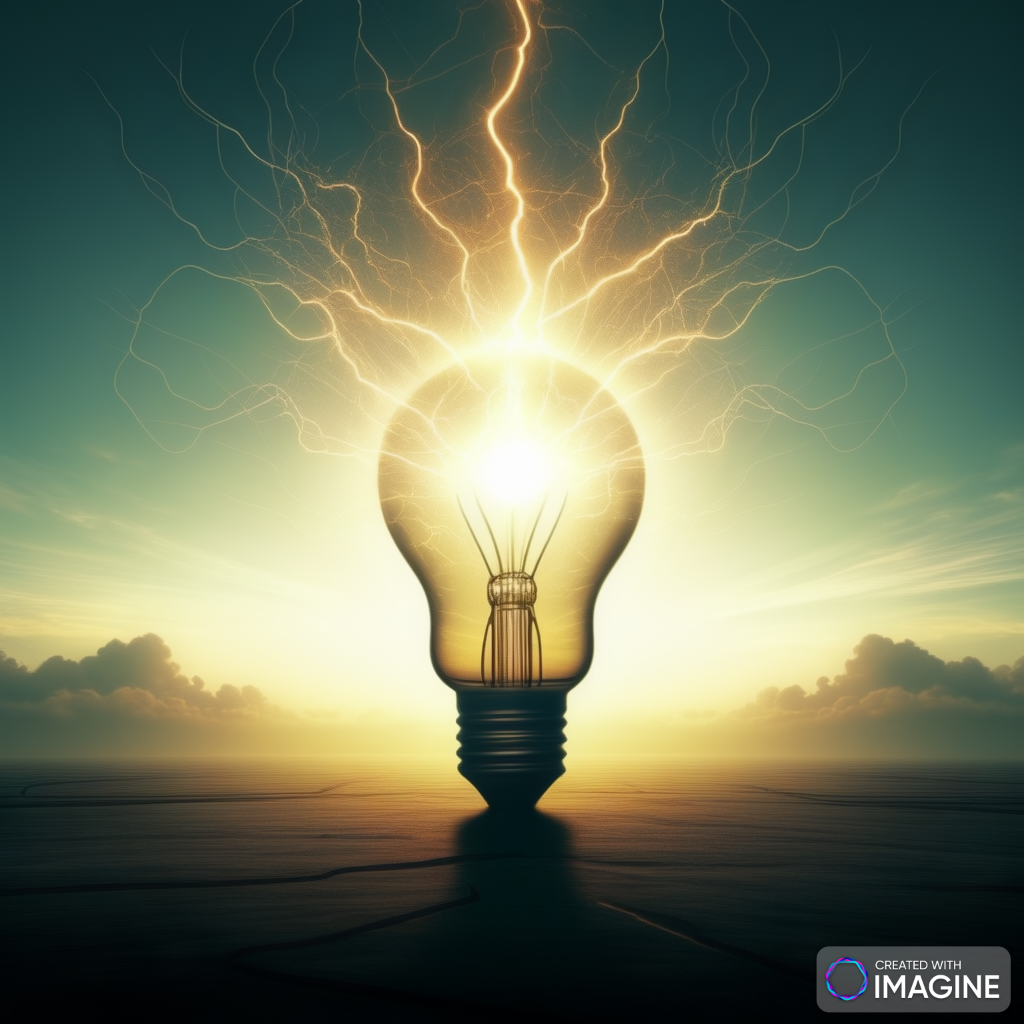Introduction: Electricity, the invisible force that powers our modern world, is the result of centuries of scientific inquiry, experimentation, and technological innovation. In this comprehensive exploration, we delve into the fascinating history, science, and engineering behind the discovery and harnessing of electricity, shedding light on its profound impact on human civilization.
The Birth of Electricity:
- Origins of Curiosity:
- The journey to understanding electricity traces back thousands of years to ancient civilizations that observed and interacted with natural phenomena like lightning and static electricity. Early Greek philosophers such as Thales of Miletus (circa 600 BCE) were among the first to study the properties of static electricity, recognizing its ability to attract lightweight objects like feathers when rubbed with certain materials. Similarly, William Gilbert, an English physician and natural philosopher in the late 16th century, conducted groundbreaking experiments with various substances to explore the nature of magnetism and static electricity.
- Thales of Miletus is credited with being one of the first to document observations about the attractive properties of amber when rubbed with fur, a phenomenon we now understand as static electricity. His inquiries laid the groundwork for later scientific investigations into the nature of electricity and magnetism.
- William Gilbert, on the other hand, is renowned for his systematic studies of magnetism and electricity. In his seminal work “De Magnete” (1600), he documented extensive experiments with lodestones (naturally occurring magnets) and other substances to understand their magnetic properties. Gilbert’s contributions provided crucial insights into the fundamental principles of electricity and magnetism, setting the stage for further scientific inquiry and experimentation.
- These early inquiries into electricity laid the foundation for subsequent scientific advancements, leading to the development of electrical theories and principles that continue to shape our understanding of the modern world.
- Benjamin Franklin’s Lightning Experiment:
- Alessandro Volta’s invention of the first electric battery in 1800 marked a pivotal moment in the history of electricity. Volta, an Italian physicist, devised a revolutionary device known as the voltaic pile, which consisted of alternating layers of zinc and copper discs separated by cardboard soaked in saltwater or acidic solution.
- The key innovation of Volta’s battery was its ability to generate a continuous flow of electrical current. Each pair of zinc and copper discs, known as a cell, produced a small voltage when immersed in the electrolyte solution. By stacking multiple cells on top of each other, Volta created a cumulative effect, resulting in a higher voltage output.
- One of the significant contributions of Volta’s battery was its practical utility. Unlike previous electrostatic generators, which could only produce brief bursts of static electricity, Volta’s voltaic pile provided a steady and reliable source of electric current. This breakthrough laid the foundation for numerous applications of electricity in various fields.
- Volta’s voltaic pile sparked widespread interest and experimentation in electricity, leading to rapid advancements in electrical science and technology. Scientists and inventors began exploring the properties of electric current, developing new instruments for measuring and harnessing its power.
- Volta’s invention also played a crucial role in the development of electromagnetism, as researchers like Hans Christian Ørsted and André-Marie Ampère conducted experiments that revealed the relationship between electricity and magnetism.
- Moreover, Volta’s battery paved the way for the invention of electric motors, telegraphs, and other devices that would transform industries and communication systems in the years to come. The voltaic pile became the precursor to modern batteries, which power everything from smartphones to electric vehicles.
- In summary, Alessandro Volta’s creation of the first electric battery revolutionized the field of electricity, providing a practical and reliable source of electrical energy. His voltaic pile not only advanced scientific understanding but also paved the way for countless technological innovations that continue to shape the modern world.
Understanding Electricity: 3. Unraveling the Nature of Electricity:
Michael Faraday and James Clerk Maxwell made groundbreaking contributions to the understanding of electricity and magnetism, laying the foundation for modern electromagnetism.
Michael Faraday, a self-taught British physicist and chemist, conducted pioneering experiments in the early 19th century that led to the discovery of electromagnetic induction. In 1831, Faraday discovered that a changing magnetic field could induce an electric current in a nearby circuit. This fundamental principle, known as Faraday’s law of electromagnetic induction, revolutionized the generation of electric power.
Faraday’s experiments with electromagnetic induction also led to the development of the first electric generator, demonstrating the practical application of his discoveries. His work laid the groundwork for the modern electrical power industry, enabling the widespread distribution of electricity for lighting, heating, and other purposes.
James Clerk Maxwell, a Scottish physicist, mathematically formalized Faraday’s experimental results and developed a comprehensive theory of electromagnetism. In the 1860s, Maxwell published his famous set of equations, known as Maxwell’s equations, which unified the previously separate theories of electricity and magnetism.
Maxwell’s equations describe how electric and magnetic fields interact and propagate through space, predicting the existence of electromagnetic waves. Maxwell demonstrated that light itself is an electromagnetic wave, providing a profound insight into the nature of light and its relationship to electricity and magnetism.
Maxwell’s theory of electromagnetism laid the theoretical groundwork for numerous technological advancements, including wireless communication, radio transmission, and radar. His equations also played a crucial role in the development of Albert Einstein’s theory of relativity and the subsequent understanding of the fundamental laws of physics.
Together, Faraday and Maxwell’s work transformed our understanding of electricity and magnetism, revealing the intimate connection between these two phenomena. Their discoveries paved the way for the development of modern electromechanical devices, communication systems, and technologies that have revolutionized society.
- From Static to Current:
- The evolution of understanding from static electricity to electric currents marked a significant transition in the study of electricity, culminating in Alessandro Volta’s invention of the voltaic pile and André-Marie Ampère’s contributions to electromagnetism.
- Early Observations of Static Electricity:
- The study of electricity dates back to ancient civilizations, where observations of phenomena like lightning and static charges laid the groundwork for early understandings of electricity. Scholars like Thales of Miletus in ancient Greece noted the attraction of amber to certain objects after being rubbed, demonstrating the phenomenon of static electricity.
- Transition to Electric Currents:
- The shift from static electricity to electric currents began with the exploration of conductive materials and the development of devices capable of producing continuous electrical flow. In the 18th century, experiments by scientists like Luigi Galvani and Alessandro Volta challenged prevailing notions of electricity as solely a static phenomenon.
- Alessandro Volta and the Voltaic Pile:
- Alessandro Volta, an Italian physicist, is credited with inventing the first electric battery, known as the voltaic pile, in 1800. Volta’s invention consisted of alternating layers of zinc and copper discs separated by moistened cardboard or cloth soaked in an electrolyte solution. This arrangement produced a continuous electric current when connected in a circuit, demonstrating the ability to generate electricity through chemical reactions.
- Contributions of André-Marie Ampère:
- André-Marie Ampère, a French physicist and mathematician, made significant contributions to the understanding of electromagnetism. In the early 19th century, Ampère formulated mathematical equations describing the relationship between electric currents and magnetic fields, known as Ampère’s law. He demonstrated that electric currents produce magnetic fields and that moving magnets induce electric currents, laying the groundwork for the study of electromagnetism.
- Integration of Theory and Experimentation:
- Volta’s voltaic pile and Ampère’s theoretical framework provided a cohesive understanding of electricity as a dynamic force generated by the flow of electric charge. Their work exemplified the integration of theory and experimentation in advancing scientific knowledge, paving the way for further discoveries in electromagnetism and electrical engineering.
- Impact on Science and Technology:
- The developments by Volta and Ampère revolutionized the fields of science and technology, leading to advancements in electrical power generation, transmission, and utilization. Their contributions laid the foundation for modern electrical systems, including batteries, generators, motors, and electrical circuits, which form the backbone of contemporary society.
- In summary, the evolution from static electricity to electric currents, epitomized by Volta’s voltaic pile and Ampère’s contributions to electromagnetism, represents a pivotal period in the history of electricity. Their work transformed the study of electricity from a curiosity into a fundamental scientific discipline with profound implications for technology and society.
Harnessing Electricity: 5. The Birth of Electric Circuits:
The development of electric circuits, resistors, and conductors played a crucial role in harnessing electricity for practical applications, laying the groundwork for modern electrical systems and devices.
- Early Electrical Circuits:
- The concept of electric circuits emerged as scientists and engineers sought to control and manipulate the flow of electric charge. Early experiments with batteries and conductive materials led to the creation of simple circuits consisting of interconnected components through which electric current could flow.
- Introduction of Resistors:
- Resistors are components designed to restrict the flow of electric current in a circuit. They were introduced to regulate the amount of current flowing through different parts of a circuit, ensuring that devices received the appropriate level of electrical power. Early resistors were often made from materials with high resistance, such as carbon or metal alloys.
- Development of Conductors:
- Conductors are materials that allow electric charge to flow easily through them. Metals like copper, silver, and aluminum emerged as primary conductors due to their high conductivity and abundance. The development of efficient conductors facilitated the transmission of electricity over long distances with minimal loss of energy.
- Advancements in Circuit Design:
- As understanding of electrical principles deepened, engineers began to design more sophisticated circuits to meet specific requirements. This included the integration of switches, capacitors, and inductors to control the flow of current, store electrical energy, and create complex electrical behaviors.
- Innovation in Component Materials:
- Over time, advancements in materials science led to the development of new materials with tailored electrical properties. For example, semiconductor materials like silicon and germanium revolutionized electronics by enabling the creation of diodes, transistors, and integrated circuits, which form the basis of modern electronic devices.
- Impact on Technology:
- The development of electric circuits, resistors, and conductors paved the way for numerous technological advancements across various industries. From the electrification of homes and businesses to the proliferation of electronic gadgets and communication systems, electricity has become indispensable in modern life.
In summary, the development of electric circuits, resistors, and conductors represents a cornerstone in the history of electrical engineering. These foundational components enabled the practical application of electricity, driving innovation and shaping the technological landscape of the modern world.
- Thomas Edison and the Light Bulb:
- Thomas Edison’s invention of the practical incandescent light bulb in 1879 marked a significant milestone in the history of technology, transforming the way people illuminated their homes and workplaces. Here’s a detailed exploration of this groundbreaking achievement:
- Background and Early Experiments:
- Prior to Edison’s work, various inventors and scientists had experimented with incandescent lighting, but their designs were inefficient and impractical for widespread use. Edison recognized the need for a reliable and commercially viable electric lighting system and embarked on a series of experiments to develop a better solution.
- Edison’s Approach:
- Edison and his team at Menlo Park Laboratory conducted extensive research to find the ideal filament material that could produce a bright, long-lasting light when heated by an electric current. They experimented with thousands of materials, including carbonized bamboo, cotton thread, and platinum wire, before settling on a carbonized filament made from bamboo.
- Development of the Incandescent Bulb:
- After numerous trials and iterations, Edison successfully created a practical incandescent light bulb with a filament that could withstand high temperatures without burning out quickly. The bulb consisted of a sealed glass enclosure containing the filament, which was connected to electrical leads. When an electric current passed through the filament, it heated up and emitted light through incandescence.
- Commercialization and Impact:
- In 1879, Edison demonstrated his incandescent light bulb to the public, showcasing its reliability and efficiency compared to existing lighting technologies like gas lamps and candles. He established the Edison Electric Light Company to manufacture and distribute electric lighting systems, laying the foundation for the modern electric utility industry.
- Advancements in Lighting Infrastructure:
- Edison’s invention sparked a rapid expansion of electric lighting infrastructure, with cities and towns adopting electric streetlights and businesses and households installing electric bulbs. This transition from gas and oil lamps to electric lighting improved safety, productivity, and quality of life for millions of people.
- Legacy and Continued Innovation:
- Edison’s incandescent light bulb remained the primary source of electric lighting for over a century until more energy-efficient alternatives like fluorescent and LED bulbs emerged. Nevertheless, his invention paved the way for countless innovations in lighting technology and laid the groundwork for the electrification of society.
- In summary, Thomas Edison’s invention of the practical incandescent light bulb revolutionized the way people lived and worked, ushering in a new era of illumination powered by electricity. His pioneering work exemplifies the power of scientific innovation to drive progress and improve the quality of life for humanity.
- Alternating Current vs. Direct Current:
- The rivalry between Nikola Tesla and Thomas Edison over the adoption of alternating current (AC) versus direct current (DC) power systems, famously known as the “War of Currents,” was a pivotal chapter in the history of electricity. Here’s a detailed exploration of this contentious competition:
- Background and Context:
- In the late 19th century, Edison was a prominent figure in the burgeoning electric power industry, having established himself with the invention of the practical incandescent light bulb and the development of DC power systems. Meanwhile, Nikola Tesla, a brilliant inventor and engineer, arrived in the United States with ambitious ideas for harnessing AC electricity.
- Edison’s Advocacy for DC Power:
- Thomas Edison championed direct current (DC) as the preferred method for transmitting electrical power. DC systems supplied a steady current flow in one direction and were initially adopted for lighting and small-scale electrical applications. Edison was heavily invested in DC technology and sought to maintain its dominance in the emerging electric utility market.
- Tesla’s Promotion of AC Power:
- Nikola Tesla, on the other hand, recognized the limitations of DC power systems, particularly their inability to efficiently transmit electricity over long distances. He advocated for alternating current (AC), which periodically reverses direction and can be easily converted to different voltage levels using transformers. Tesla believed that AC offered superior efficiency and scalability for large-scale power generation and distribution.
- The Battle for Market Dominance:
- As Tesla’s AC system gained traction for its practical advantages, a fierce rivalry ensued between proponents of AC and DC technologies. Edison, fearing the loss of his market share, launched a smear campaign against AC, emphasizing its perceived dangers and promoting the safety of DC. This included public demonstrations where animals were electrocuted using AC currents to showcase its supposed hazards.
- Westinghouse and the Niagara Falls Project:
- George Westinghouse, a prominent entrepreneur and engineer, recognized the potential of Tesla’s AC system and formed the Westinghouse Electric Corporation to promote its adoption. The company secured a contract to build the power generating station at Niagara Falls using Tesla’s AC technology, marking a significant victory for AC over DC.
- Legal and Public Relations Battles:
- The rivalry escalated into legal battles and propaganda campaigns, with Edison and Westinghouse competing for lucrative contracts to electrify cities and power transportation systems. Despite Edison’s efforts to undermine AC, the superior efficiency and versatility of Tesla’s AC system ultimately prevailed, leading to its widespread adoption in the electric power industry.
- Legacy and Impact:
- The “War of Currents” marked a pivotal moment in the history of electrical engineering, highlighting the importance of technological innovation and competition in driving progress. Tesla’s contributions to AC power transmission revolutionized the electric utility industry, laying the foundation for the modern electrical grid and enabling the widespread electrification of society.
- In summary, the rivalry between Nikola Tesla and Thomas Edison over AC versus DC power systems, while fraught with controversy and competition, ultimately led to significant advancements in electrical engineering and the adoption of more efficient and scalable power transmission technologies.
Applications of Electricity: 8. Powering the Industrial Revolution:
The advent of electricity played a transformative role in fueling the Industrial Revolution, driving innovation across various sectors and catalyzing unprecedented economic growth. Here’s a detailed exploration of how electricity powered the Industrial Revolution:
- Factory Automation:
- Electricity revolutionized manufacturing processes by replacing traditional mechanical power sources such as waterwheels and steam engines. Electric motors provided a more flexible and efficient means of powering machinery in factories, allowing for greater precision, control, and productivity. Factories could now operate around the clock, leading to increased output and economies of scale.
- Mass Production and Assembly Lines:
- With the introduction of electrically powered machinery, factories could implement mass production techniques and assembly line systems more effectively. Electrically driven conveyor belts, cranes, and other automated systems facilitated the rapid assembly of products, enabling manufacturers to streamline production processes and reduce costs. This led to the mass production of goods ranging from textiles and automobiles to consumer electronics.
- Transportation Revolution:
- Electricity transformed transportation systems, particularly railways and urban transit networks. Electric locomotives replaced steam engines, offering smoother acceleration, quieter operation, and reduced pollution. Electric streetcars and subway systems emerged in major cities, providing efficient and affordable public transportation options for urban commuters. Electric power also facilitated the development of electric elevators, enabling the construction of taller buildings and skyscrapers.
- Urban Electrification:
- The widespread adoption of electricity spurred urban electrification efforts, transforming cityscapes with illuminated streets, buildings, and public spaces. Electric lighting replaced gas lamps and oil lanterns, enhancing safety, visibility, and nightlife. Electric power also enabled the operation of electric streetlights, traffic signals, and electric signage, contributing to the modernization and beautification of urban environments.
- Technological Innovation:
- The availability of electricity spurred technological innovation in various industries, from telecommunications and entertainment to healthcare and agriculture. Electrically powered machinery revolutionized textile production, leading to the mechanization of spinning, weaving, and dyeing processes. Electric telegraph and telephone systems facilitated rapid communication over long distances, connecting people and businesses across the globe. Electrically powered appliances such as refrigerators, washing machines, and vacuum cleaners revolutionized household chores, improving standards of living and freeing up time for leisure activities.
- Economic Impact:
- The widespread adoption of electricity fueled economic growth and prosperity, driving industrialization, urbanization, and globalization. Electricity-intensive industries such as steel manufacturing, chemical processing, and electronics production flourished, creating jobs and wealth. The increased efficiency and productivity enabled by electricity lowered the cost of goods, making them more accessible to consumers and stimulating demand. Overall, electricity played a central role in shaping the modern world and laying the foundation for the technological advancements of the 20th century.
- Electrifying Communication:
- The role of electricity in telecommunications has been instrumental in revolutionizing the way humans communicate over vast distances. Here’s a detailed exploration of its evolution:
- Telegraphy:
- Samuel Morse’s invention of the telegraph in the early 19th century marked a pivotal moment in telecommunications history. The telegraph utilized electrical signals to transmit messages over long distances using a system of wires and electromechanical devices. Morse code, a series of dots and dashes representing letters of the alphabet, was employed to encode and decode messages. The telegraph enabled near-instantaneous communication between distant locations, revolutionizing long-distance correspondence and facilitating the rapid exchange of information.
- Telephone:
- Alexander Graham Bell’s invention of the telephone in 1876 represented another significant milestone in telecommunications. Unlike the telegraph, which transmitted coded messages, the telephone allowed for real-time voice communication between individuals separated by distance. The telephone relied on electrical signals generated by sound waves to transmit audio signals over copper wires. Bell’s invention transformed interpersonal communication, enabling individuals to converse with each other in real-time regardless of their physical location. The telephone network expanded rapidly, connecting homes, businesses, and government offices, and laying the groundwork for the modern telecommunications infrastructure.
- Expansion and Integration:
- As electricity became more widely available and infrastructure networks expanded, telecommunication systems grew in complexity and scope. Telephone exchanges, equipped with switchboards and relays, were established to route calls between subscribers. The development of multiplexing techniques allowed for the simultaneous transmission of multiple signals over a single communication channel, increasing the efficiency and capacity of telecommunication networks. Telegraph and telephone lines were laid across continents and under oceans, linking distant regions and facilitating global communication networks.
- Technological Advancements:
- The evolution of telecommunications was driven by ongoing technological advancements and innovations. The introduction of wireless telegraphy by Guglielmo Marconi in the late 19th century enabled communication over radio waves, paving the way for wireless telegraphy and radio broadcasting. The invention of the vacuum tube and later semiconductor technologies revolutionized signal amplification and modulation, leading to the development of electronic communication devices such as radios, televisions, and computers.
- Modern Telecommunications:
- Today, electricity continues to play a central role in modern telecommunications infrastructure. Fiber-optic cables, satellite networks, and cellular communication systems rely on electrical signals to transmit data and voice communications across vast distances. Digital technologies, including the Internet, email, and mobile phones, have further transformed the way people communicate, enabling instant messaging, video conferencing, and access to vast repositories of information. The integration of electricity and telecommunications has revolutionized society, facilitating global connectivity and shaping the way we interact and communicate in the digital age.
- Modern Marvels: From computers and smartphones to electric vehicles and renewable energy systems, uncover the myriad ways electricity shapes our contemporary world.
The Science-Engineering Nexus: 11. Bridging Science and Technology:
The interdisciplinary nature of electricity encompasses a dynamic interplay between scientific discoveries and technological advancements, each driving and shaping the other in a continuous feedback loop. Here’s a detailed exploration of this phenomenon:
- Scientific Discoveries Informing Technology:
- Scientific breakthroughs in understanding the fundamental principles of electricity have paved the way for revolutionary technological advancements. For example, discoveries in electromagnetism by scientists like Michael Faraday and James Clerk Maxwell laid the foundation for the development of electric generators, motors, and transformers. By elucidating the relationship between electricity and magnetism, these discoveries provided the theoretical framework upon which electromagnetic devices and systems are built.
- Technological Advancements Driving Scientific Research:
- Conversely, technological advancements have often driven scientific research by enabling new methods of experimentation and observation. For instance, the invention of powerful electromechanical devices such as voltmeters, ammeters, and oscilloscopes provided scientists with the tools needed to measure and analyze electrical phenomena with unprecedented accuracy. These instruments facilitated the empirical study of electricity and led to further discoveries in areas such as electrical resistance, capacitance, and inductance.
- Feedback Loop between Theory and Practice:
- The relationship between scientific theory and technological practice forms a feedback loop, with advancements in one domain often catalyzing progress in the other. For example, theoretical insights into quantum mechanics have led to the development of semiconductor technologies, enabling the miniaturization of electronic components and the creation of integrated circuits. These technological innovations, in turn, have spurred further research in quantum physics, leading to new theoretical frameworks and understandings.
- Interdisciplinary Collaboration:
- The interdisciplinary nature of
 fosters collaboration between scientists, engineers, and technologists from diverse fields. This collaboration facilitates the translation of theoretical insights into practical applications and vice versa. For instance, physicists may work alongside electrical engineers to develop new materials with specific electrical properties, while computer scientists may collaborate with neuroscientists to model the electrical activity of the brain.
fosters collaboration between scientists, engineers, and technologists from diverse fields. This collaboration facilitates the translation of theoretical insights into practical applications and vice versa. For instance, physicists may work alongside electrical engineers to develop new materials with specific electrical properties, while computer scientists may collaborate with neuroscientists to model the electrical activity of the brain.
- The interdisciplinary nature of
- Impact on Society and Innovation:
- The synergy between scientific discoveries and technological advancements in electricity has had a profound impact on society and fuelled innovation across various sectors. From the electrification of cities and the development of telecommunications networks to the creation of consumer electronics and renewable energy technologies, electricity has transformed the way we live, work, and communicate. The interdisciplinary nature of electricity continues to drive progress and inspire new avenues of research and development, shaping the future of technology and society.
- From Lab to Market:
- Scientific research on electricity serves as the foundation upon which engineering innovations are built, leading to the development of transformative technologies across various domains. Here’s a detailed exploration of how scientific discoveries translate into engineering innovations:
- Understanding Fundamental Principles:
- Scientific research elucidates the fundamental principles governing electricity, such as Ohm’s law, Faraday’s law of electromagnetic induction, and Maxwell’s equations. Engineers leverage this understanding to design and optimize electrical systems and devices.
- Development of Electrical Machines:
- Scientific insights into electromagnetism have led to the creation of electrical machines like generators and transformers. These devices rely on electromagnetic induction to convert mechanical energy into electrical energy (generators) or vice versa (transformers). Engineers refine these designs to improve efficiency, reliability, and performance.
- Advancements in Electronics:
- Discoveries in semiconductor physics, quantum mechanics, and solid-state physics have driven innovations in electronics. Engineers harness these insights to develop semiconductor devices like diodes, transistors, and integrated circuits (ICs). Integrated circuits, in particular, have revolutionized the field by enabling the miniaturization, integration, and mass production of electronic components.
- Digital and Analog Circuit Design:
- Engineers apply principles from circuit theory, signal processing, and communication theory to design digital and analog circuits for a wide range of applications. Digital circuits process discrete signals using Boolean logic and binary representation, while analog circuits handle continuous signals with varying amplitude and frequency. These circuits form the backbone of modern electronics, from microprocessors and memory chips to amplifiers and sensors.
- Power Systems and Renewable Energy:
- Scientific research on electricity informs the design and operation of power systems, including transmission networks, distribution grids, and renewable energy technologies. Engineers optimize the generation, transmission, and distribution of electrical power to meet demand efficiently while minimizing losses and environmental impact. Renewable energy technologies, such as solar panels and wind turbines, capitalize on scientific principles to harness clean, sustainable sources of electricity.
- Superconductors and Advanced Materials:
- Breakthroughs in materials science and condensed matter physics have led to the discovery and development of superconductors—materials that exhibit zero electrical resistance at low temperatures. Engineers leverage superconductivity to create high-performance electrical devices, such as magnetic resonance imaging (MRI) machines, particle accelerators, and power transmission lines. Additionally, advances in nanotechnology enable the engineering of novel materials with tailored electrical properties for specific applications.
- Cross-Disciplinary Collaboration:
- Collaboration between scientists and engineers across disciplines drives innovation and fosters interdisciplinary research. By bridging the gap between theory and practice, engineers translate scientific knowledge into practical solutions that address real-world challenges. This collaborative approach accelerates the pace of technological advancement and contributes to the continuous evolution of the electrical engineering field.
- In summary, scientific research on electricity serves as a springboard for engineering innovations, enabling the development of transformative technologies that shape our modern world. By leveraging fundamental principles and interdisciplinary collaboration, engineers harness the power of electricity to drive progress and improve lives.
Conclusion: Through centuries of inquiry, experimentation, and ingenuity, humanity has unlocked the power of electricity, illuminating the world and driving progress across diverse domains. As we continue to push the boundaries of scientific discovery and technological innovation, electricity remains a beacon of human achievement and a testament to the boundless potential of human ingenuity.






